Wed 12 Sep 2012
Movie Review: THE HOUSE OF THE ARROW (1953).
Posted by Steve under Mystery movies , Reviews[7] Comments
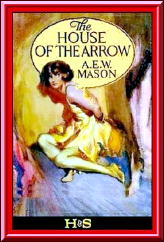
THE HOUSE OF THE ARROW. Associated British Pictures, UK, 1953. Oskar Homolka (Inspector Hanaud), Robert Urquhart, Yvonne Furneaux, Josephine Griffin, Harold Kasket, Pierre Lefevre, Pierre Chaminade. Based on the novel by A. E. W. Mason (Hodder, 1924). Director: Michael Anderson.
This is the third of three adaptations of Mason’s classic detective novel to the screen. The other two (1930 and 1940, respectively) are said not to exist. (If this is not true, I’d like to be corrected on this statement.) I first read the book a long time ago – a Modern Library Giant that contained two other works I also consider classics: Trent’s Last Case and Before the Fact – but alas, never since. (It has since been reprinted in an easy to obtain paperback published by Carroll & Graf in 1984.)
In any case, while I’d like to be able to contrast the book with the film, I cannot. My memory does not go back nearly that far, almost 60 years ago. So I must encourage you to take the comments that follow with as large a grain of salt that you can muster, but they are, I assure you, well intentioned and (I hope) worthy of further discussion.
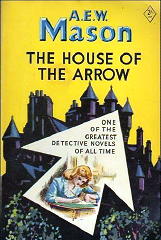
As good as this movie is – and it is very good – I think what it displays is that no one can make a movie based on a work of detective fiction and have it work as well as it did in printed form. Movies and episodes of various TV series have been made that are excellent detective puzzlers, so it can be done.
I’d include the Jim Hutton season of Ellery Queen shows in the latter category, and many of the Murder, She Wrote series. You can name your own movies, including those made for TV, but I doubt that many of the ones you might bring up were based on printed novels or even short stories, if any at all, and if they were, I’m willing to wager that the original printed version was better.
I’m talking fair play detective fiction, mind you, not suspense thrillers, or noir fiction. Some of the Suchet versions of Poirot stories follow the originals closely, but are they better? I’ve been watching the first season of the Perry Mason television series, for example, and most of the shows I’ve watched are simply awful, with gaps in continuity and logic that are simply bewildering. Maybe they existed in Erle Stanley Gardner’s novels, too, and I’m willing to concede that maybe they were. I’m almost afraid to go back and see for myself.
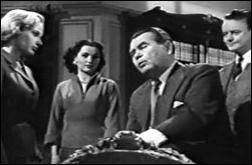
Perhaps it’s that the pure puzzle category of detective fiction doesn’t translate well to film, or that film people simply don’t know how to do it. They have to jazz up Miss Marple and even Hercule Poirot so much, even to changing the endings (is that really so?), that they could change the names of all the characters and no one would have any ideas where the stories came from.
I think (but as I suggested above, I am not sure) that the producers of this cinematic version of The House of the Arrow intended to follow the story line of the book as closely as possible. I’ll assume that to be the case.

There are plenty of false trails for this to be true, although only a small number of suspects, a French manor house where the murder takes place (if it was indeed murder) so intricately filled with connecting rooms and corridors that Inspector Hanaud of the French Surete must carry floor plans of the building around with him as he goes, a mysterious poison brought back to France from South America (I believe) on an antique arrowhead, and a detective (the aforementioned Hanaud) who is the epitome of Golden Age detectives: jaunty, pugnacious, all-knowing, and positively beaming with delight to be confronted with a case that’s up the challenge of his abilities, of which he can assure you, are second to none.
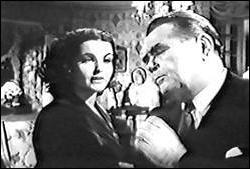
And Oskar Homulka is positively the right actor for the job. Not particularly handsome, his flair for the dramatic, as well as the comic jest at just the right time, is right on, every moment of the film. The black-and-white photography is superb, near noir-like in the angles that are taken and the mood that is invoked. Dead is an old woman, presumably of natural causes, but some anonymous letters and a disgruntled would-be heir cause suspicion to be aroused.
But I confess, it took me two viewings to follow the story, and while I know who and why, I’m still not sure exactly sure how the many details that put who, why and how fit together in a nicely satisfying whole. Nor is this is not a fair play mystery, one in which you say to yourself “Of course,†and slap yourself on the head with a “Doh†when all is revealed. The book may be equally at fault in this regard. If any of you reading this have read the book more recently than I, or have better memories, can say yea or nay in this regard, please do.
A very enjoyable movie, nonetheless, in spite of this long and perhaps rambling preamble, with lots of thoughts and no complete answers on my part, I’m afraid, but if you’ve read this far, you really ought to see this movie, if it ever comes your way.
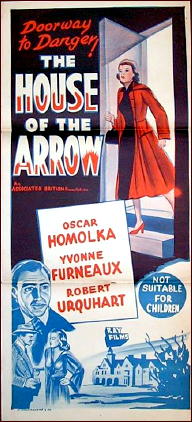
September 12th, 2012 at 8:48 pm
Thanks for the smart, helpful review.
I love the puzzle-mystery form, and the emphasis on depicting the work of detection that accompanies that form–but I’ve long thought that the form doesn’t translate very well to the medium of film (or to television, for that matter). By contrast, I love suspense movies and movie thrillers, whereas I’m often bored by suspense and thriller fiction. To make a puzzle mystery work, you need to keep a wide range of clues and characters in play, and that’s just hard to do on film. Even at its best (e.g., the Jim Hutton EQ series, or the William Powell version of “The Kennel Murder Case”), the filmed puzzle tale can seem plodding and tedious in comparison to a literary version of the same material. Which isn’t to say that I don’t film versions of my favorite detective stories. But I’m always aware that those works are rubbing against the limitations of their medium.
September 12th, 2012 at 11:38 pm
The visual arts versus the written word have many differences that effect how a story can be told. Time is the most obvious, but there are others.
Reading is an active role, the reader must fill in the blanks and create the world and characters. Being part of the creation of the story shifts the reader’s focus where he or she is more attentive to details such as clues, etc.
TV and film are passive entertainment. The world is created for us, the pace of the story is not in our control, what the characters look like is done for us.
In a book, you can go back and find clues and things you might have missed earlier. Even if you read the book in one night, you have more time to think and consider what is happening.
Unless you are watching a DVD or download, in TV and film you keep up or get left behind.
The structure is different. TV stories are based on commercial breaks, a mini climax are required at certain points (based on time not the story need). This is why twists are so popular with TV mysteries.
Pay TV is the exception and usually uses a more film structure.
But books also have a different structure, a different rhythm, than film. While TV has the commercial break, the book has the chapter break.
The book offers something film and TV can’t, the third person all knowing narrator. This allows the reader to know what the character is thinking and solves the exposition problem that plagues the visual story of TV and film.
To play fair with the mystery in TV and film the clues have to be shown.
A writer can write a good who-done-it once a year or so, but few can do it every week.
The puzzle mystery is an intellectual exercise that rewards thought over action. The character mystery is more visually suitable with action that TV and film require.
September 13th, 2012 at 11:44 am
Mike and Michael
Excellent — and detailed — observations both. Thanks!
I’m convinced more than ever that while a excellent mystery puzzle movie or TV show can be made, it’s a lot less likely it can be done by adapting a novel in printed form. A short story might be easier to work with, but even so, it would probably be better to start from “scratch,” and work with all of the advantages that visual media provides, while being careful not to forget its limitations.
Michael, I can’t improve on your comparative analysis between the printed page and film/TV, so more than this, I won’t even try.
I’m not sure why any of this never quite coalesced in my mind before. Perhaps during my break from posting here last month I had more time to answer the question I asked myself while watching THE HOUSE OF THE ARROW, which was “Why isn’t this working?”
September 14th, 2012 at 1:30 pm
One of my favorite pastimes is to read a book in conjunction with watching the film made of it: Read a few chapters through the day, watch the corresponding scenes at night. It’s interesting to note the structural changes wrought by the different art forms.
As far as being able to “flip back the pages” in a movie, in this day and age of DVDs and such, it’s relatively easy. My wife and I saw the movie NIGHT HAS A THOUSAND EYES a while back, and after it was over, she had me back it up to a crucial scene and sure enough, there in the background, the least-likely suspect was up to no good while the director had us looking elsewhere.
A final note on the book HOUSE OF THE ARROW: I believe it was this book that artist John Willie cited as a strong influence on his work.
September 14th, 2012 at 6:07 pm
Dan
Yes, thank goodness for the guys that invented DVDs. In more ways than one. What would we do without them?
If I hadn’t been watching HOUSE OF THE ARROW on DVD and had the opportunity to see it again all the way through a second time the next night following, I would have been lost. I had a basic idea of what happened, and I still enjoyed the movie very much, but a second time through showed me what I’d missed, and it was quite a bit.
One problem I had that I didn’t mention was that the picture quality on the disk I have was not the best. This didn’t help at all. There are a lot of scenes that take place in darkness, and they didn’t show up well.
Another interesting aspect was that since the movie takes place in France, a lot of the dialogue was in French, without translation. The viewer is left on his own to figure it out in context — not that difficult, but I don’t think any movie made in the US would dare do this, not as extensively as was done in this one.
Every once in a while during his investigation Hanaud would stop a witness and say, “In English, please, for the benefit of Mr. Frobisher” (the English barrister representing Betty Harlowe, accused of the crime). Nicely done.
September 15th, 2012 at 12:08 am
As for John Willie, there seems to have been more to the book version of THE HOUSE OF THE ARROW than I remember reading.
Take for example:
http://jebsadventurebound.homestead.com/files/did_1.html
These portions of the movie seem to have somewhat rewritten.
June 11th, 2015 at 1:00 pm
I love the book THE HOUSE OF THE ARROW since decades, re-reading it with pleasure from time to time, although I know the sentences well. Recently (strangely so late ?) I bought the last (1953) of the three movies, disliked it tremendously, but realized the sad facts of artistic life:
The scenario writer can freely distort any novel, adding scenes that make NO sense and leaving out meaningful parts, in the name of making a film as a new artwork, even if “based on a book”.
This book deserves a be better treatment as a BBC TV production with 3-6 installments. The story consists of many subtle details that can be well handled if you have more time.
In a movie lasting 70-90 minutes, every minute has to be carefully utilized for the substantial moments of the story, and not wasted in a non-constructive procedure.
People who saw this movie will not know what a good story The House of The Arrow really is.
I hope that someone will return and use this classic piece of literature to make a excellent show.